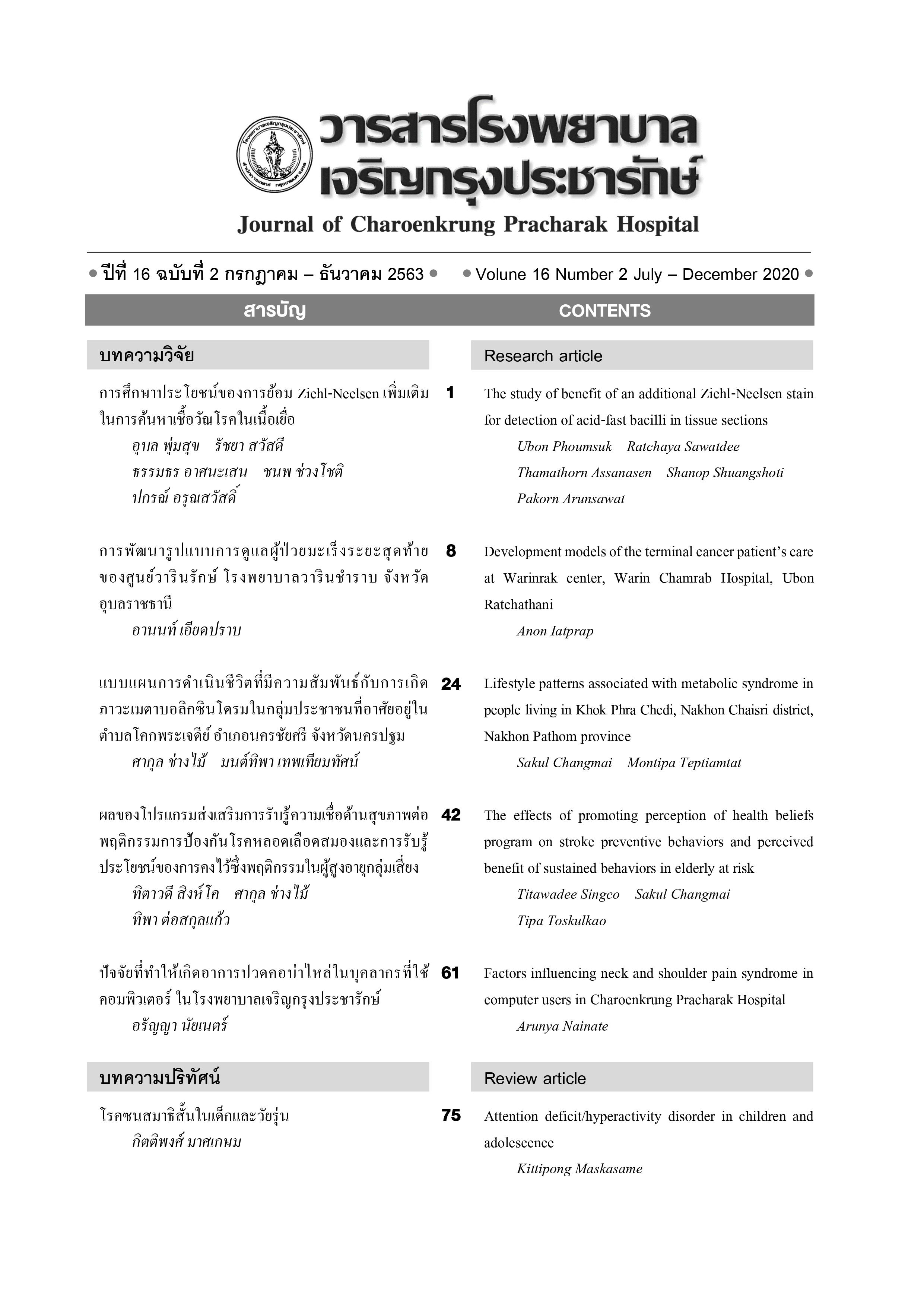Acute pulmonary embolism after spine surgery in lumbar spinal stenosis: A case report
Main Article Content
Abstract
Pulmonary embolism (PE) is a serious condition in orthopedic surgery. The incidence of PE is quite lowbut it is high risk for morbidity and mortality . The role of pharmacologic thomboprophylaxis remains controversial in spine surgery. Some trials reported acute pulmonary embolism in pre-operative thromboprophylaxis patients. Management including type of anticoagulants and time to treat with anticoagulant in pulmonary embolism after spine surgery vary and depend on opinion of physicians. A75- year- old Thai female presented with severe back pain and diagnosed as spinal cord stenosis L4-L5,with kyphotic deformity was admitted for laminectomy L4-L5,transforaminal lumbar interbody fusion L5-S1 and pedicular screw fixation ,T6-S1 except right side of T10 with ostectomy T10-T12 and repair dura L4-L5 and posterior fusion T6-L5. Postoperative day 3 patient developed sudden dypsnea and hypoxemia. Computer tomography pulmonary artery reveals filling defect occupying nearly entire anterior segmental branch of left upper lobe pulmonary artery and lateral basal segment of left lower lobe pulmonary artery, lateral basal segment and posterior basal segment of right lower lobepulmonary artery. Moderate tricuspic regurgitation and high right ventricular systolic pressure were detected by transthoracic echocardiography.The patient was diagnosed intermediate risk pulmonary embolism and treated with intravenous heparin under closed observation for bleeding tendency and subdural hematoma in spinal cord Dypsnea was improved gradually without active bleeding condition then heparin was switched to subcutaneous enoxaparin .Enoxaparin was stopped after INR more than 1.8 and warfarin was continued. The patient was discharged without serious complications.
Article Details
References
followingspine surgery occurring while under chemical thromboprophylaxis. Eur Spine J 2008
Jul; 17(7): 970-4.
2. Silverstein MD, Heit JA, Mohr DN, Petterson TM, O'Fallon WM, Melton LJ 3rd . Trends in the
incidence of deep vein thrombosis andpulmonary embolism: a 25-year population based study. Arch
Intern Med 1998; 158: 585-93.
3. Heit JA. The epidemiology of venous thromboembolism in the community: implications for prevention
and management.J Thromb Thrombolysis 2006; 21: 23-9.
4 Chotigavanichaya C, Ruangchainikom M, Piyavanno C. Incidence of symptomatic pulmonary
embolism in spine surgery. J Med Asso Thai 2014; 97(9): s73-7.
5. Pineda LA, Hathwar VS, Grant BJ. Clinical suspicion of fatal pulmonary embolism. Chest
2001; 120: 791-5.
6. Barnes B, Alexander JT, Branch CL Jr. Postoperatives level 1 anticoagulation therapy and spinal
surgery practical guideline for management. Nero Sur Focus 2004; 17(4):e5.
7. Geerts WH, Heit JA, Pineo GF, Colwell CW, Anderson FA Jr, Wheeler HB.Prevention of venous
thromboembolism. Chest 2001; 119(suppl l): s132-75.
8. Goldhaber SZ, Visani L, De Rosa M.Acute pulmonary embolism: clinical outcomes in the
International Cooperative Pulmonary Embolism Registry (ICOPER). Lancet 1999; 353:1386-9.
9. Brian BS, Elizabeth JL, Ehsan J, Tristan BW,Timothy C, Nicholas C, et al.Postoperative deep vein
thrombosis, pulmonary embolism, and myocardial Infarction: complications after therapeutic
anticoagulation in the patient with spine trauma. Spine J 2018: 17; 970-4.
10. Kearon C, Akl EA, Ornelas J, Blaivas A, Jimenez D, Bounameaux H. Chest guideline for
antithrombotic therapy for VTE. Chest 2016; 149: 315-52.
11. บูรพา ปุสธรรม.โรคลิ่มเลือดอุดกั้นในหลอดเลือดปอดเฉียบพลัน.ศรีนครินทร์เวชสาร 2557; 29(5):
485-96.
12. Kearon C.Natural history of venous thromboembolism. Circulation 2003; 107(23 suppl 1): I22–I30.
13. Laporte S, Mismetti P, Decousus H, Uresandi F, Otero R, Lobo JL, et al. Clinical predictors for fatal
pulmonary embolism in 15,520 patients with venous thromboembolism: findings from the Registro
Informatizado de la EnfermedadThromboembolica venosa (RIETE) Registry.Circulation 2008; 117:
1711-16.
14. Anderson FA Jr, Spencer FA.Risk factors for venous thromboembolism.Circulation 2003; 107(23
Suppl1):I9-16.
15. McIntyre KM, Sasahara AA. The hemodynamic response to pulmonary embolism in patients without
prior cardiopulmonary disease. Am J Cardiol 1971; 28: 288-94.
16. Kim HJ, Walcott-Sapp S, Adler RS, Pavlov H, Boachie-Adjei O, Westrich GH. Thromboembolic
complications following spine surgery assessed with spiral CT. Hospital for Special Surgery(HSSJ)
2011; 7: 37-40.
17 . Wolf SJ, Hahn SA, Nentwich LM, Raja AS, Silvers SM, Brown MD. Clinical policy: critical issues
in the evaluation and management of adult patients presenting to the emergency department with
suspected acute venous thromboembolic disease. Ann Emerg Med2018; 71(5):e59-109.
18. Doria C, Caggiari G, Mosele GR, Puddu L. Role of early low-molecular-weight heparin
prophylaxis in the surgical treatment of degenerative spinal diseases in the elderly patients.
Surgical Science 2016; 7: 375-80.
19. Oliveira L, Luis Marchi L, Pimenta L. Up-To-Date thrombophophylaxis in elective
spine surgery. A systemic review. Coluna/Columna 2014; 13(2): 143-6.
20. Nijkeuter M, Hovens MM, Davidson BL, Huisman MV. Resolution of thromboemboli in patients
with acute pulmonary embolism: a systematic review. Chest 2006; 129: 192-7.
21. Kasper W, Konstantinides S, Geibel A, Olschewski M, Heinrich F, Grosser KD, et al.Management
strategies and determinants of outcome inacute major pulmonary embolism: Journal of the American
College of Cardiology 1997; 30(5): 1165-71.
22. Dalen JE. Pulmonary embolism: what have we learned sinceVirchow? Natural history,
pathophysiology, and diagnosis. Chest 2002; 122:1440-56.
23. Piazza G, Goldhaber SZ. Acute pulmonary embolism: part I:epidemiology and diagnosis.Circulation
2006; 114: e28-32.
24. Jaff MR, McMurtry MS, Archer SL, Cushman M, Goldenberg N, Goldhaber SZ.Management
of massive and submassive pulmonary embolism,iliofemoral deep vein thrombosis, and
chronic thromboembolic pulmonary hypertension. A scientific statement from the American Heart
Association. Circulation 2011; 123: 1788-830.
25. Konstantinides SV, Meyer G, Becattini C, Bueno H, Geersing GJ, Harjola VP,et al. ESC Guidelines
for the diagnosis and management of acute pulmonary embolism developed in collaboration with the
European Respiratory Society (ERS). Eur Heart J 2019; 00: 1-61.


